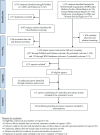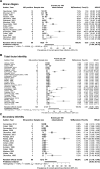Global epidemiology of Neisseria gonorrhoeae in infertile populations: systematic review, meta-analysis and metaregression
- PMID: 32423944
- PMCID: PMC7892374
- DOI: 10.1136/sextrans-2020-054515
Global epidemiology of Neisseria gonorrhoeae in infertile populations: systematic review, meta-analysis and metaregression
Abstract
Objective: To provide an in-depth systematic assessment of the global epidemiology of gonorrhoea infection in infertile populations.
Methods: A systematic literature review was conducted up to 29 April 2019 on international databases and WHO regional databases, and reported following Preferred Reporting Items for Systematic Reviews and Meta-Analyses guidelines. All prevalence measures of gonorrhoea infection among infertile populations, based on primary data, qualified for inclusion. Infertile populations were broadly defined to encompass women/men undergoing infertility evaluation or treatment (infertility clinic attendees and partners). Pooled mean prevalence by relevant strata was estimated using random-effects meta-analysis. Associations with prevalence and sources of heterogeneity were explored using metaregression. Risk of bias was assessed using four quality domains.
Findings: A total of 147 gonorrhoea prevalence studies were identified from 56 countries. The pooled mean prevalence of current gonorrhoea infection was estimated globally at 2.2% (95% CI 1.3% to 3.2%), with the highest prevalence in Africa at 5.0% (95% CI 1.9% to 9.3%). The mean prevalence was higher for populations with tubal factor infertility (3.6%, 95% CI 0.9%-7.7%) and mixed cause and unexplained infertility (3.6%, 95% CI 0.0% to 11.6%) compared with other diagnoses, such as ovarian and non-tubal infertility (0.1%, 95% CI 0.0% to 0.8%), and for secondary (2.5%, 95% CI 0.2% to 6.5%) compared with primary (0.5%, 95% CI 0.0% to 1.7%) infertility. Metaregression identified evidence of variations in prevalence by region and by infertility diagnosis, higher prevalence in women than men and a small-study effect. There was a trend of declining prevalence by about 3% per year over the last four decades (OR=0.97, 95% CI 0.95 to 0.99).
Conclusions: Gonorrhoea prevalence in infertile populations is several folds higher than that in the general population, with even higher prevalence in women with tubal factor infertility and in individuals with secondary infertility. These findings support the potential role of gonorrhoea in infertility and suggest that some infertility is possibly preventable by controlling gonorrhoea transmission.
Prospero registration number: CRD42018102934.
Keywords: Neisseria gonorrhoeae; epidemiology (general); gonorrhoea; infertility.
© Author(s) (or their employer(s)) 2021. Re-use permitted under CC BY-NC. No commercial re-use. See rights and permissions. Published by BMJ.
Conflict of interest statement
Competing interests: The authors have no conflicts of interests to declare.
Figures


Similar articles
-
Global epidemiology of Neisseria gonorrhoeae in infertile populations: protocol for a systematic review.BMJ Open. 2019 May 22;9(5):e025808. doi: 10.1136/bmjopen-2018-025808. BMJ Open. 2019. PMID: 31122971 Free PMC article.
-
Epidemiology of gonorrhea in countries of the Middle East and North Africa: systematic review, meta analyses, and meta regressions.BMC Glob Public Health. 2024 Aug 19;2(1):56. doi: 10.1186/s44263-024-00088-9. BMC Glob Public Health. 2024. PMID: 39681952 Free PMC article.
-
Epidemiology of gonorrhoea: systematic review, meta-analyses, and meta-regressions, World Health Organization European Region, 1949 to 2021.Euro Surveill. 2024 Feb;29(9):2300226. doi: 10.2807/1560-7917.ES.2024.29.9.2300226. Euro Surveill. 2024. PMID: 38426239 Free PMC article.
-
Genital Chlamydia trachomatis and Neisseria gonorrhoeae infections among women in sub-Saharan Africa: A structured review.Int J STD AIDS. 2018 Jul;29(8):806-824. doi: 10.1177/0956462418758224. Epub 2018 Feb 28. Int J STD AIDS. 2018. PMID: 29486628 Review.
-
Serological and clinical correlates of gonorrhoea and syphilis in fertile and infertile Nigerian women.Genitourin Med. 1997 Jun;73(3):194-7. doi: 10.1136/sti.73.3.194. Genitourin Med. 1997. PMID: 9306900 Free PMC article.
Cited by
-
Chlamydial and Gonococcal Genital Infections: A Narrative Review.J Pers Med. 2023 Jul 21;13(7):1170. doi: 10.3390/jpm13071170. J Pers Med. 2023. PMID: 37511783 Free PMC article. Review.
-
Are sexually transmitted infections associated with male infertility? A systematic review and in-depth evaluation of the evidence and mechanisms of action of 11 pathogens.Arab J Urol. 2023 Jul 5;21(4):216-232. doi: 10.1080/2090598X.2023.2218566. eCollection 2023. Arab J Urol. 2023. PMID: 38178949 Free PMC article. Review.
-
The antimicrobial resistance landscape of Neisseria gonorrhoeae in New Zealand from November 2018 to March 2019 and the role of sexual orientation in transmission.Microb Genom. 2021 Nov;7(11):000701. doi: 10.1099/mgen.0.000701. Microb Genom. 2021. PMID: 34755593 Free PMC article.
-
Viruses, bacteria and parasites: infection of the male genital tract and fertility.Basic Clin Androl. 2023 Jul 20;33(1):19. doi: 10.1186/s12610-023-00193-z. Basic Clin Androl. 2023. PMID: 37468865 Free PMC article. Review.
-
Estimates of the incidence, prevalence, and factors associated with common sexually transmitted infections among Lebanese women.PLoS One. 2024 Apr 18;19(4):e0301231. doi: 10.1371/journal.pone.0301231. eCollection 2024. PLoS One. 2024. PMID: 38635688 Free PMC article.
References
-
- Zegers-Hochschild F, Adamson GD, Dyer S, et al. . The International glossary on infertility and fertility care, 2017. Fertil Steril 2017;108:393–406. - PubMed
-
- World Health Organization Multiple definitions of infertility, 2019. Available: https://wwwwhoint/reproductivehealth/topics/infertility/multiple-definit... [Accessed 7th Jul 2019].
Publication types
MeSH terms
LinkOut - more resources
Full Text Sources
Medical
Miscellaneous
